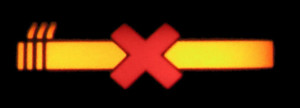Why are there still ashtrays in airplanes?
By on Oct 3rd 2016
Don't let the ashtrays fool you--inflight smoking is banned on U.S. airliners
If you've flown in a commercial airplane any time in the past 25 years, you've definitely seen one of these:

The universal signal for no smoking in an airplane (found on most airlines worldwide).
No Smoking Allowed
Inflight smoking is banned by almost all airlines today. According to FAA regulations, smoking lit cigarettes, or anything else that produces smoke or flame, is prohibited on board most commercial aircraft. This includes e-cigarettes: In October 2015-USDOT prohibited use of electronic cigarettes on flights (and further prohibited such devices from being transported in checked luggage).
The flight attendants union began fighting for a smoking ban in the late 1960s.
In 1971, United Airlines was the first company to enact a nonsmoking section.
In 1984, the Civil Aeronautics Board (Federal agency that regulated aviation services; disestablished January 1, 1985) banned smoking on all domestic fligths of 2 hours or less--and then unbanned it in favor of sticking with smoking or nonsmoking sections. The move to unban smoking was, at least in part, due to chairman Dan McKinnon's swing vote. McKinnon said, "Philosophically, I think nonsmokers have rights, but it comes into market conflict with practicalities and the realities of life."
Despite CAB's flip-flop, Congressional action in 1987 led to a ban on inflight smoking.
The smoking ban first took effect beginning in April 1988 on all domestic flights with a duration of two hours or less. The ban was extended to domestic flights of six hours or less in February 1990, under President George H.W. Bush. In 2000, smoking was prohibited on flights between the US and foreign destinations.
Not everyone was happy about the smoking ban, however, as you can see in the video below:
Despite the ban on smoking, commercial aircraft are still required to have ashtrays.
Why, you might wonder? Because people don't always follow the rules (even if it means a $500 fine and potential detainment).
The following is written into the US Code Of Federal Regulation for Airworthiness:
(g) Regardless of whether smoking is allowed in any other part of the airplane, lavatories must have self-contained, removable ashtrays located conspicuously on or near the entry side of each lavatory door, except that one ashtray may serve more than one lavatory door if the ashtray can be seen readily from the cabin side of each lavatory served.
The FAA seems to recognize that banning something isn't going to prevent people from doing it. In 2007, for instance, Amy Winehouse spent about half of her one hour flight to Glasgow smoking in the toilet; no action was taken against her. On February 3, 2013, a family of four were accused of smoking during a flight from Halifax to the Dominican Republic; the flight made an emergency landing at Bermuda L.F. Wade International Airport. Two of the four were arrested and sentenced to a $500 fine or 10 days in prison.
A banned cigarette is much more dangerous if there is no place to safely dispose it.
Since preventing passengers from smoking in the bathrooms continues to be a challenge, providing a safer means to extinguish and dispose of cigarette butts is the most ideal. Smoke and fire in an airplane is a hazardous combination-- in fact, fire in the air is one of the most hazardous situations a flight crew can face. Once a fire becomes established, it's unlikely that crews will be able to put it out.
One example of how devastating a fire caused by a cigarette can be occurred before the smoking ban. On 24 December 1982, CAAC Flight 2311 was travelling from Changsha Huanghua International Airport to the former Guangzhou Baiyun International Airport. After the Ilyushin Il-18 landed at Baiyun Airport, a cabin fire (caused by a passenger's cigarette) produced toxic smoke-- the crew stopped the aircraft on the runway and evacuated the passengers. The fire killed 25 passengers, seriously injured 22 passengers and four crew members, and destroyed the aircraft.
Whether it's exploding cell phone batteries or cigarettes, cabin fires are no joke. It's always best to adhere to airline regulations to help ensure a safe and efficient flight.
Sources:
https://en.wikipedia.org/wiki/Inflight_smoking
http://www.ecfr.gov/cgi-bin/text-idx?node=se14.1.2...
http://www.skybrary.aero/index.php/Fire_in_the_Air...
https://en.wikipedia.org/wiki/CAAC_Flight_2311







